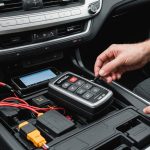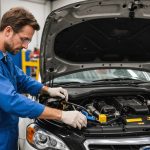Overview of Emergency Braking Systems
Emergency braking systems (EBS) are critical components in vehicle safety, specifically designed to prevent accidents and reduce the severity of crashes. These systems are autonomous or driver-initiated technologies that enhance the braking performance of a vehicle by applying maximum brake force when a potential collision is detected. By minimizing human error and reaction times, emergency braking systems serve to protect both passengers and pedestrians on the road.
EBS are paramount for road safety. They significantly reduce stopping distances, which is crucial in high-speed situations or sudden traffic changes. Their implementation in modern vehicles underscores the industry’s commitment to minimising road fatalities and injuries.
Also to see : Exploring the Pros and Cons of Car Subscription Services in the UK: Benefits, Drawbacks, and What You Need to Know!
There are various types of emergency braking systems, each tailored to specific scenarios and vehicle designs:
- Automatic Emergency Braking (AEB): Utilises sensors to detect obstacles and autonomously applies brakes if the driver fails to react in time.
- Anti-lock Braking System (ABS): Prevents wheels from locking by modulating brake pressure, maintaining grip and control.
- Brake Assist System: Detects emergency braking situations and provides additional braking power to reduce stopping distance.
Understanding these systems empowers drivers to appreciate their vehicle’s safety features and make informed decisions when purchasing or operating a vehicle.
Key Components of Emergency Braking Systems
Delving into the braking system components, an effective emergency braking system comprises several critical elements that ensure the safety and reliability of a vehicle. Regular vehicle inspections are essential to maintain these components in top condition.
Brake Pads and Shoes
At the heart of any braking system, brake pads and shoes play a crucial role. They create the friction needed to slow down a vehicle when pressed against the rotor or drum. Over time, these components wear down, potentially compromising brake hardware efficiency. Monitoring their wear and tear is vital. Always ensure they are above the manufacturer’s recommended thickness to maintain optimal performance.
Brake Fluid
Brake fluid is another essential component, facilitating the transfer of force from the brake pedal to the brakes themselves. Regular vehicle inspections should include checking the fluid levels and its quality. Contaminated or low brake fluid can lead to brake failure. Replace or top up the fluid as specified in the vehicle’s manual to prevent any adverse effects.
Warning Lights and Indicators
Modern vehicles come equipped with warning lights and indicators on the dashboard. These alerts serve a crucial function; understanding them enhances safety. For instance, a lit brake warning light might indicate low fluid levels or require brake system attention. Heeding these alerts promptly during vehicle inspections can prevent more significant issues.
Detailed Inspection Checklist
When it comes to vehicle maintenance, a thorough inspection checklist ensures optimal safety and performance. It is vital to systematically assess various components of your vehicle.
Visual Inspection
Start with a meticulous visual inspection involving both the exterior and interior of the vehicle. Examine lights, wipers, and mirrors for functionality and cleanliness. Ensure tyres are in good condition with appropriate tread depth. Assess the undercarriage for any leaks or signs of wear.
Operational Test
Performing an operational test is crucial, especially for systems like brakes. To test brake efficiency, conduct a short road test in a controlled environment. Listen for unusual noises and feel for any vibrations or pulling to one side. This will help you identify potential issues with brake performance early.
Maintenance Records
Keeping detailed maintenance records is essential. Regularly update logs to track services performed, parts replaced, and any brake check outcomes. This documentation not only aids in future vehicle maintenance planning but also enhances the vehicle’s resale value. Having comprehensive records allows a clearer understanding of a vehicle’s history and anticipates upcoming service needs. It serves as a guide for what has been done and what still requires attention, promoting preventative maintenance and avoiding potential failures.
Common Issues and Troubleshooting
Dealing with braking issues is crucial for maintaining optimal vehicle performance. Here, we’ll delve into common indicators of braking problems, explore solutions for brake fade, and understand when professional help is necessary.
Identifying Warning Signs
It’s essential to recognize early signs of braking issues to ensure safety. Common indicators include squeaking brakes, a vibrating brake pedal, or a longer stopping distance. If you notice a grinding noise, it might suggest worn-out brake pads. A spongy pedal might indicate air in the braking system or brake fluid leakage. Identifying these early can prevent serious damage and costly repairs.
Dealing with Brake Fade
Brake fade is a temporary reduction in stopping power caused by excessive heat. This often occurs during prolonged or heavy braking, such as on steep descents. To combat brake fade, allow brakes to cool by using engine braking and avoiding continuous use. Ensuring brake components are in good condition can help minimize fade. Replace worn-out pads or discs and check for fluid leaks to maintain performance.
When to Seek Professional Help
While minor issues might be DIY-friendly, significant braking problems require professional attention. If the brake warning light turns on, it’s imperative to consult a mechanic. Regular professional inspections can identify unseen issues, ensuring effective brake troubleshooting and optimal vehicle performance.
Conclusion and Best Practices
To ensure vehicle safety and longevity, adopting best practices is essential. Regular routine maintenance is crucial for enhancing safety. Tasks such as checking tyre pressure, inspecting brake pads, and ensuring fluid levels are optimal can prevent unnecessary risks on the road. Establishing a regular inspection schedule helps in identifying potential issues before they become serious problems.
One of the key elements of preventative maintenance is setting up reminders or schedules for these inspections. This could be monthly or quarterly, depending on the vehicle usage. By doing so, drivers can stay ahead of wear and tear, thus maintaining the safety and efficiency of their vehicles.
Educating drivers plays a pivotal role in vehicle safety. Understanding emergency braking features is vital. Many modern vehicles come equipped with advanced systems designed to protect occupants during sudden stops. Familiarity with these systems can significantly improve response times and effectiveness in emergencies.
Furthermore, sharing vehicle safety tips among drivers fosters a culture of responsibility and awareness. This ensures that all drivers are equipped with the necessary knowledge to handle unexpected road situations and maintain their vehicles properly, ultimately contributing to overall road safety.











